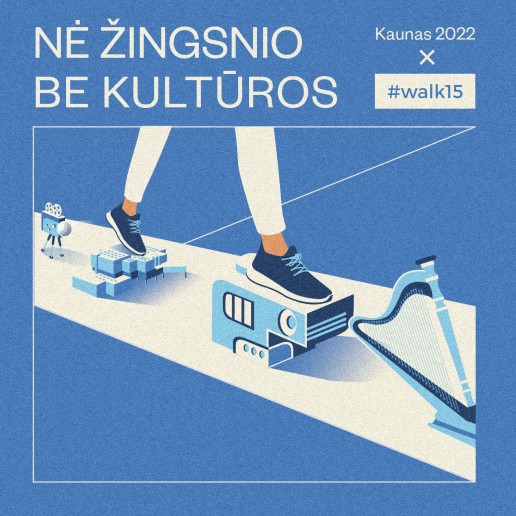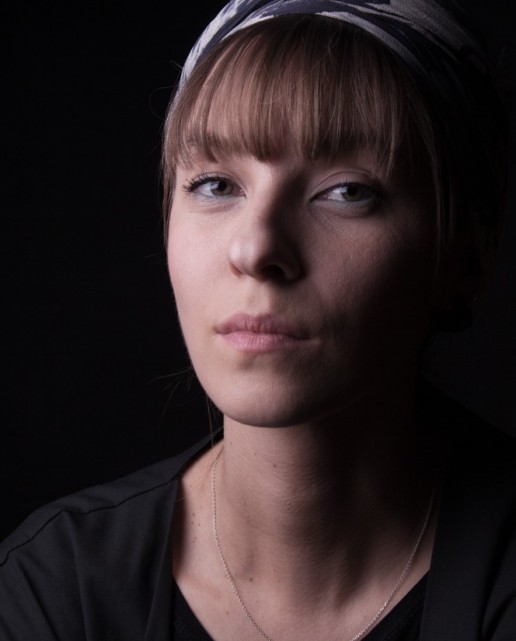Kultūros sostinė Kauno miestą ir rajoną kviečia priimti iššūkį – nė žingsnio be kultūros!
Šiandien, sausio 21 d. – ypatinga diena Kauno miestui ir rajonui. Lygiai po metų Kaunas, kartu su Serbijos miestu Novi Sad bei Liuksemburgo Esch-sur-Alzette atsidurs visos Europos dėmesio centre – taps Europos kultūros sostinėmis.
Read more
Slow fashion designer V. Strasevičiūtė: “Clothes shopping is like a spreading virus. I’d love to take a glimpse at your wardrobe”
Do you renew the contents of your wardrobe each time shops have announcements for sales and the start of a new season? If yes, how much of your wardrobe’s clothing is unwanted and no longer worn? And are clothes really designed only for a single season? Slow fashion designer V. Strasevičiūtė suggests that sometimes we require very little – simply to think before making a purchase.
One of the slow fashion initiative’s Upcycled by LT creators, designer V. Strasevičiūtė, has been interested in fashion since childhood. To be exact, she had questions which we sometimes do not ask ourselves for years. Or do not ask at all. Vida has been working in the slow movement for eight years already. Last year, she joined Kaunas – European Capital of Culture 2022 team and will become an ambassador, her message being sustainable consumption. Consumption culture, sustainability and sustainable consumption are one of Kaunas 2022 Programme’s focus areas: it is part of culture, and sustainable consumption enhances, fosters, conserves, and preserves the environment.
“My mother worked in the fur industry for many years, and during my childhood I would wander around her workplace. I would see how much raw material would be left over. I would also see how they would sew articles from scraps and would sell them cheaper – as if second-rate. It was very interesting to me, seemed paradoxical, that such an expensive material, which requires so much more handwork, is being sold cheaper,” contemplated V. Strasevičiūtė.
Vida, did the questions raised in your childhood dictate your life’s direction – you chose studies related to fashion?
I studied costume design and I have always been interested in issues created by the fashion industry. Intuitively. Eventually, I understood that my lifestyle embodied the term “slow fashion“. My interests, hobbies were to construct something, to create something from what is already there, and in that way to give it a second life. I started to delve deeper and search for examples of what is happening in the world, fashion industry, what are the solutions for using up scraps, remnants. I realised that this is a growing phenomenon in the world.
During study years, I started to experiment more with fur. Soon, I realised that the price of a product made of remnants and scraps can only be raised with the aid of design. That means that one must find new methods, new forms of expression. It is important not to waste the raw material. It is also important to value handwork. During research for my master’s thesis, I was able to meet with companies and see the amounts of leftovers post-production. That is how I chose this direction: to utilise that which is already there, and not to use anything new to produce another garment. Everything started with fur scraps, and later solutions were various. Now, we are working with wool remnants and other fabrics too.
Do you yourself notice a bigger interest? Who are your customers?
In our case, it is slightly complicated due to the use of real fur, its opposition in society. The task is a little more difficult because after hearing and seeing that it is real leather, many do not wish to listen any further, to learn that these are sheepskin scraps, which in other case would be wasted. However, we do our best not to waste the already existing raw materials. Fur is a very durable one. Many still own old fur coats in their wardrobes, and they feel bad about throwing them away because, after all, it is fur. To wear – the design is too outdated. That is why we provide another service: designing a new piece from what the client owns. This really paid itself off and more and more people are contacting us, asking to give an item a second life. Concerning selection, it is clear that people are becoming more conscious about the clothes’ history and handwork, it is becoming more important. And also, being an ambassador – you choose to breathe new life into an old item, not to purchase a new one.
Where can we browse your products?
On social media, the platform etsy.com, where you can find us by our name – Upcycled by LT.
You have said that our perception of clothing has become distorted so much so that the consequences are becoming catastrophic. What did you mean by that?
I am talking about mass consumption and about the fact that the market has normalised shopping without consideration for the manufacturer of the clothes, the material from which they are made, about following brands and the frenzied pace of fashion. The production of such clothing is increasing. The clothes are not yet sold out, but new ones are already arriving on the shelves. That is how pollution levels grow. My suggestion is for everyone to look at themselves and consider why, how many, and for how long the articles of clothing are being purchased. In England, research was conducted on how many garments people purchase, which they end up never wearing. According to previous research data, England spends 30 billion pounds per year for clothes which are not worn once. And these numbers are only growing, they reflect that the need to be clothed is being replaced by a mindless need to shop.
Clothes shopping is like a spreading virus. But why, for what? That is how clothing loses its primary purpose – only the wish to own more remains. This applies as much to fashion as to other industries.
If we look at large shopping centres, clothes shops dominate. What motivates us to purchase new clothes – just advertisements or certain root causes?
In terms of Lithuania, I believe that the historical roots run quite deep. For a long time, we have lived in times of deficit, when there was nothing. And then suddenly everything opened its doors. Besides the fact that the assortment is growing, dropping prices, of course, contribute to it too. That is when you start to feel almighty, and able to own everything, to own plenty. You are affluent in the number of items and clothes.
But I am pleased that in the public sphere and mass media sustainable fashion and consumption are increasingly more discussed. People look back and understand that they do not need this much, that trying to still this unquenchable thirst leads to us simply owning too much. And we no longer know what to do with these things. Then we throw them away. More and more people are beginning to understand that this is wrong. Pollution is enormous, and recycling of textile is an issue to which the solution is yet to be found.
Clothing retailers announce new seasons yearly. What is a new clothing season, and overall can a piece of clothing have its own season, finally – can it become worn out in such a short time?
It is an advertising trick because they must always renew, provide something fresh for people’s eyes in order to evoke the desire to buy. And the seasons... that is the key to fast fashion. And, let’s face it, they do not offer high-quality clothing. That is why often they last for only one season.
What is more, the number of seasons is not diminishing – there is more of them. Collections are being introduced in-between seasons, which are being constantly expanded and restocked. Before, there were two collections: fall-winter and spring-summer. Now up to 8 collections can be counted. It is absurd. However, fast fashion is not suitable for everyone. Research shows that more and more of smaller niche shops prove to be successful, which cater to relevant and timely customers’ needs.
Last year, together with the partner Kaunas - European Capital of Culture 2022, you have proposed an initiative Tvarink Spintą (Sustainable Wardrobe). That was clothes design for particular people according to their needs, problems which they face, using that which is around them. You have created looks for ten people of different professions, needs, and appearance. What kind of experience was it for you?
It was an experiment, very interesting and fun. When I was getting in touch with the Lithuanian Council of Culture for a grant, that is when the idea of this initiative was born. I realised that conveying my values and ideas to the broader public is quite difficult because the large ones often upstage us. But working with individual people by considering their practical needs and problems, offering alternative choices, solutions was interesting. To show that one can redesign that which they own, to create that which fits their figure, to use up remnants and scraps – I really felt that it left a strong impression.
After the project one of the participants brought me their old coat and said: “I thought about throwing it away, but you taught us that you mustn’t. So maybe something can be done with it?”. People realised that there is an alternative. Each of the project’s participants took away a certain experience. My goal was to make that experience as profound and memorable as possible. I wanted them to wear the clothes which they were bringing home with genuine pleasure and further spread the message of sustainable consumption, slow fashion.
After all, each of these ten participants have their own circle of people they interact with. Therefore, in daily situations or when asked, where this outfit is from, it will spread the idea of sustainability. In this way, awareness will spread through small steps.
What would you say to everyone considering sustainable consumption?
One thought, which is all-encompassing. All clothing can be sustainable if we all accept the responsibility to make sure it lasts as long as possible. If we ourselves become bored of it, perhaps we can offer it to one of our friends? Of course, there are charity funds, initiatives, where you can donate unwanted clothing. But often it is a riddance – it is as if you have done a good deed, but these garments are not necessarily needed by anyone.
That is why first we should offer it to our friends, to whom the clothes may fit and appeal. There also exist platforms, where one can sell, give away. Thus, such choices are the said responsibility of making clothing last as long as possible.
Does shopping in second-hand shops fall under the label of sustainability?
Yes, of course. I would consider the support of local producers, tailors, and designers as a sustainable choice as well. And, in a second-hand shop you might discover something which will surprise and remain in the wardrobe long-term. It is important to avoid the fast cycle, which is offered by shops.
Vida, if invited you over and showed my wardrobe, would you suggest what I could do with clothes I no longer wear?
You hit the nail on the head. The project’s Tvarink Spintą (Sustainable Wardrobe) direction was to work with individual people. I did not visit their homes. They would bring the clothes themselves. But I would gladly accept this wardrobe experiment. I’d love to take a glimpse at your wardrobe.
Original text by Jurgita Lieponė, journalist of 15min. You can find the original text in 15min.lt website here.



